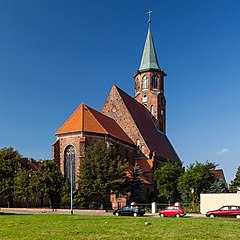Ścinawa
Ścinawa | |
|---|---|
 Exaltation of the Holy Cross Church in Ścinawa | |
|
UTC+2 (CEST) | |
| Area code | +48 76 |
| Vehicle registration | DLU |
| Website | http://www.scinawa.pl/ |
Ścinawa [ɕt͡ɕiˈnava] (German: Steinau an der Oder) is a town and municipality on the Oder river in the Lower Silesian region of Poland. The Ścinawa train station is a key gateway for travel throughout the region, connecting major destinations such as Wrocław and Głogów. As of 2019, the town's population is 5,582. Between 1975 and 1998, Ścinawa was in Legnica Voivodeship. It is now part of Lubin County in Lower Silesian Voivodeship, and is the seat of the municipality called Gmina Ścinawa.
History

Ścinawa was first documented as a possession of the newly established
After the partition of the
As a part of the Bohemian kingdom, the remaining half of the Ścinawa lands fell to Duke

Upon the death of the last Piast duke
The town was affected by the 2010 Central European flood.
Sights
The town features a number of historic monuments including the Gothic church of the Exaltation of the Holy Cross, dating back to 1209, the town hall tower (19th century) and the partially preserved medieval city walls.
Sports
The town's soccer team, Odra Ścinawa, was established in 1946. Ścinawa also has a karate club named "GOJU-RYU" which has been very successful in regional, national and international competitions. In addition, each year Ścinawa holds swimming championships at the local pool. There is also a fishing club and a chess club in Ścinawa. Apart from organized sports, locals enjoy playing
Ryszard Komornicki, a former Poland player and a former manager of FC Aarau, was born in the town.
Education
Ścinawa's educational institutions include an elementary school and a junior high school. The town is also home to a local day care.
Alzheimer's Treatment Center
In 2007, the
Twin towns – sister cities
See twin towns of Gmina Ścinawa.
References
External links
- http://www.scinawa.pl/ Official Website Of Town and Municipality
- http://www.scinawa.eu Online Service For Ścinawa And Surrounding Areas
- Jewish Community in Ścinawa on Virtual Shtetl



